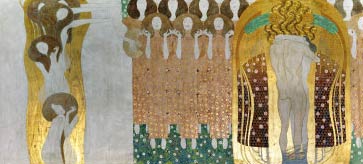In preparation for the 14th Vienna Secessionist exhibition, Klimt completed the Beethoven Frieze in 1902
Whilst intended to be a temporary artwork purely for that end, it was preserved and eventually restored to display permanently.
Klimt chose to work directly on the walls of the Vienna Secession Building though hadn't planned for it to be stored long term. Sufficient care means it can be now enjoyed in all it's glory by thounsands of visitors to the museum every year.
The exhibition itself was a mixture of paintings, murals and sculptures aimed at celebrating and promoting the work of Beethoven.
Klimt uses mytholical themes to create a frieze which holds significant symbolic content aimed at communicating the desires of humans for happiness and love. There is also mention of the dangers from external and internal sources.
The emotions of sickness, madness, death, lust and wantonness are all represented within this artwork, with Klimt following a similar path in that sense to examples by Picasso's Blue and Purple periods, as well as The Flame by Jackson Pollock and The Scream by Edvard Munch.
In truth, these emotions have been found in many art movements, particularly those of the past two centuries when the likes of impressionism and expressionism have appeared and grown.
The frieze offers a path to hope, overcoming weaknesses and external dangers which themselves are represented by da ark, sinister-looking storm-wind giant, Typhoeus alongside his three Gorgon daughters.
There is protection and strength provided by a knight before arriving at joy and contentment with an embracing kiss. This symbol was used again by the artist in The Kiss.
Beethoven Frieze is Klimt's most famous mural work other than, perhaps, his Stoclet Frieze which itself was a bolder, more ambitious project.




